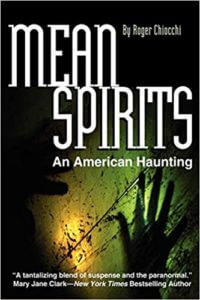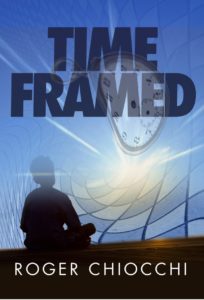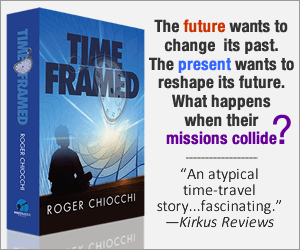

Author Roger Chiocchi
At first it seems like a battle, perhaps a war: your eyes drilling into the keyboard, desiring to liberate this story yearning to get out of your gut and hurl it onto that screen, but something hinders you. You know the concept, plot, characters and the storyline, but, damnit! you just can’t begin.
All you can do is just stare at the keyboard; QWERTY. QWERTY. QWERTY. Your fingers dangle above the keys, directionless. You just can’t think of anything to write.
Fear not, aspiring authors. This happens to everyone.
In this tutorial, we’re going to deal with that moment of thought-paralysis and cover some other basic general topics about fiction writing.
So, strap on your seatbelts and get ready for a ride!
First of all, let’s talk about some writing truisms, at least in my opinion.
1. That Critical First Sentence – You may very well be struggling with that very critical first sentence. No doubt, having a strong first sentence is important. But it’s very rare that you write what will be the ultimate first sentence during your first session at the keyboard. So, don’t worry about it. Take the pressure off yourself. Eventually, as you get into the guts of your story, that vital first sentence will come to you.

Journey to where your mind dares to take you
2. Sail Along Your Stream of Consciousness – I’ve often told my friends that very little “creating” comes at the keyboard itself. Most of my ideas – and I’ve heard similar from other writers – come when you’re doing almost anything other than writing. Taking a shower. Driving your car. Running on a treadmill. During those moments when your mind involuntarily opens up and relaxes, ideas start streaming in. Remember them. Write yourself a quick note. And, then, when you get in front of the keyboard, type it. You see, to me, you should never approach the keyboard thinking that you will create. You should approach it with a scene in mind. At the keyboard, you merely document that scene and fill in the details.
3. The “Movie” Analogy – Think of writing a novel sort of like producing a movie. The actual shooting part is akin to writing the words and sentences. Movies are almost never shot in sequence. Neither are books usually written in sequence. Multiple takes are done for each shot in a film. Most writers write and rewrite and rewrite until the scene perfectly fits the picture they have in their mind. Once you’ve completed a first draft, then the fun really begins. You have your raw material, now it’s time to refine. At this point, you’re like a film editor, analyzing all the scenes and determining which ones work which ones do not and which ones need a little work. You move things around to make your story more fluid. You revise some characters’ personalities and traits, even create new characters. I always enjoy this part.
Those are several things you should keep in mind throughout the writing process.
Now let’s get back to that initial moment of terror at the keyboard.
Actually, it’s nothing to be terrified about.

Don’t be shy. Attack those damn keys!
Just do it.
If you’re at this point, you must have a concept for your story (to see my previous tutorial on story concepts, click here). And if you have a concept for your story, you probably have a few key scenes in your head. Not completely fleshed out probably (that is what you’re going to do now), but at least a general idea of the scene – it could be a scene introducing a key character, a scene depicting a key point of conflict or even the ending scene of the entire story.
So, now, go ahead, write that scene.
It’s as simple as that. Once you start putting that scene down on paper, issues will start popping up. There may be something you have to research – the setting, some key facts – or a new character you have to develop to fill a certain role in the scene. Each time you face one of these “issues,” you are adding layers of detail to your scene, layers you may not have anticipated when your mind first conjured it up.
After you spend an hour or so at the keyboard, step away and start doing something else.

Go for it! Write that scene that’s in your head.
Then, a few hours later or maybe even the next day, go back to it, re-read it. Now start playing with the words, think of ways of conveying the same thought, only better. Add detail (you’ll will become fast friends with Google and Wikipedia as you proceed along your journey of writing your book). If you need to describe the interior of someone’s house, go to a real estate website and look at pictures of typical houses of the type you imagine or in the location of your scene. Then look for the little details that set the scene. If you need a historical reference or a scientific fact, read up on it and then use what you’ve learned to enhance the scene.
Now you’re on your way. You have a chapter or scene written. You may change this chapter many times before you have a complete book, but at least you have something. You’ve put a stake in the ground. As you crafted this chapter or scene, other ideas undoubtedly sprang into your mind. Ideas about your main characters, ideas about other scenes either preceding or following this one, ideas of other characters you’ll need. Write them down. What I like to do is write them at the bottom of the page on which I wrote the chapter or scene so I can easily access them as I proceed along with my writing.
You’ve probably heard the saying, “every journey begins with a footstep.” Well, congratulations, you’ve just taken your first footstep.
Things to Keep in Mind as Your Fingers Explore the Keyboard
In future tutorials, we will examine important elements of writing and storytelling – such as characterizations, writing a great sentence, creating powerful imagery and other important elements of the fiction writing process. But for the balance of this post, I’m going to discuss some more general concepts you should think through either before, as you begin and throughout the process of writing your book.
To Outline or Not to Outline? – When I began writing, I used to struggle over this. For my very first writing project, a screenplay, I wrote a very detailed outline recording everything on a spreadsheet, scene by scene, character by character. But as I matured into my writing career, I began to shy away from writing an outline. I came to a very important conclusion: my first draft is, in effect, a very long outline. Why? Well, firstly, writing a very detailed outline up front is very time-consuming. I’d rather spend the time actually writing the story itself. Secondly, a detailed outline limits you, boxes you in. One of the pleasures of writing is that soon you actually begin living the story, thinking like the characters, getting inside their minds, anticipating the next aspect of the storyline. It’s a lot more fun that way and, without doubt, results in a better story. Does this mean you don’t do an outline at all? Not really, of course you need a story concept and from there you should do a short outline. But keep it to a few bullet points, no more than one page, focus on the broad themes affecting the beginning, the middle and the end. And, then, start writing. That’s what it’s really all about.

Point-of-View: Stick to one.
Point-of-View – This is important and probably one of the most overlooked aspects for a beginning fiction writer. Basically, you have to figure out exactly who is telling the story and how much access that storyteller has to the minds of the characters. The two most common POVs in fiction are the First Person, where one of the characters in the book is, in effect, the storyteller and the Third Person, where the storyteller is an external voice telling the story. But it doesn’t stop there. Here are a little more detailed descriptions:
- First Person – The narrator refers to her/himself as “I” and can relate her/his thoughts but can’t dive directly into the “minds” of other characters. For instance, the First Person narrator can’t say, “Tom was frustrated,” but can say, “Tom appeared frustrated.” In other words, when referring to another characters’ inner thoughts, it has to be something the narrator, a character in the story herself, can perceive. In effect, narration in the First Person becomes dialogue: it is spoken in the narrator’s voice with all the idiosyncrasies and colloquialisms of that person’s character. For a superb example of First Person narrative, read the first few pages of The Adventures of Huckleberry Finn.
- Third Person Objective – I would venture to say this is the least used POV in fiction writing, but don’t quote me on that. In this POV the narrator is external to the story and refers to characters in the Third Person (i.e. “he” “she” “Tom” Carol” etc.) but can never delve into their minds and inner thoughts. The narrator can only relate the actual behavior of the character.
- Third Person Omniscient – This is the most fun POV, in my opinion, and the one that I use almost exclusively. In this POV, the narrator is allowed to play “God.” As in the above, the narrator is external to the story and refers to the characters in the Third Person. However, in this POV, the narrator has full access to the thoughts and inner-emotions of the characters. Everything is fair game (with some limitations, see “Avoid Head Hopping” below).
This section was not meant to be a complete review of literary POVs but basically a brief discussion to raise awareness of the issue. Much more has been written about the subject and you can find a wealth of information online.

CAUTION: Do Not Hop Around.
Avoid Head Hopping – This is actually a corollary to the section above about Point-of-View. One common problem that arises from the use of the Third Person Omniscient is a writer’s tendency to get too omniscient. It’s called head-hopping and it’s a trap I frequently fall into. While the Third Person Omniscient gives you the freedom to get inside your characters’ heads, it should only be done one character at a time. This means that in any given “scene” (realizing that a chapter can consist of one or more scenes), you should only convey the thoughts of one single character. To start doing so with more than one character in the same scene leads to confusion on the part of the reader and detracts from effective storytelling. Now, not to worry, there are a few little tricks you can use. For instance, it’s okay to state other characters’ inner thoughts and emotions but only from the point-of-view of the character whose thoughts you have already been delving into in a particular scene. In other words if you are conveying a given scene in the Third Person Omniscient from the perspective of a character named Catherine, it’s okay for Catherine to think, “Gail looked like she was upset,” (as opposed to “Gail was upset”) or “Glenn appeared frustrated,” (as opposed to “Glenn was frustrated.”) but it can only be from Catherine’s perspective to maintain the integrity of the scene and it’s Point of View.

Research opened my mind when writing Mean Spirits.
The Wanderlust of Research – Research is just as much a part of fiction writing as the actual process of writing itself. Actually, I love research because, obviously, it heightens my sensitivity to the subject of interest, but it also takes my mind on a journey. Rarely, do I stop after discovering the answer to a simple question. Usually, the act of researching something opens up new pathways. For instance, when I wrote my first novel, Mean Spirits, there was a chapter about the Mayflower’s final approach to Cape Cod. I found a wonderful book titled “Land Ho!” written in the 1920s by a Captain Sears Nickerson where he actually described the path of the Mayflower as it approached land almost minute by minute. In it, I learned about a stretch of shoals off the elbow of Cape Cod named Pollock Rip. Furthermore, I learned that the Mayflower wasn’t supposed to land in Cape Cod at all, but was “chartered” to establish a colony at the mouth of the Hudson (Jersey City?). But because of the treacherous nature of the shoals at Pollock Rip, the Mayflower was forced to turn around and eventually settle at Plymouth. I used this information to make Pollock Rip a central part of the story. Without the “wanderlust” spurred on by my research into the Mayflower and the insights of Captain Nickerson, Mean Spirits would have been a much different book.
Show vs. Tell – This is perhaps one of the easiest traps to get caught in while writing. Readers don’t want to be “told” about things (for instance, “Ted was barraged by phone calls all afternoon.”), they want to be “shown” things, almost as if being a participant in the scene themselves (i.e. instead of the sentence in parentheses above, you should show Ted being barraged by phone calls, picking up the phone, his face turning red, clicking it off time and time again, and, should he get really frustrated, throwing the phone at the wall.) Sometimes it’s okay to “tell;” for instance when you’re providing back story or background information and need to cover a great expanse of time quickly, but generally “telling” is something you should avoid as you write.
Grammar – I’m not going to spend much time on this one other than to say that you don’t have to be a grammarian to be a good writer. As a matter of fact, I once read Stephen King said that good grammar is not nearly as important as good storytelling (indeed, they are different things). That doesn’t mean to ignore grammar, but not to overly obsess over it. Once your book is ready for publication, I strongly recommend you hire a copyeditor. They will definitely “fill in the gaps” of your knowledge of grammar. If you’d like to have a good grammatical reference book, I’d recommend you get The Elements of Style by Strunk and White and/or The Chicago Manual of Style (actually they’re much more about proper usage than merely grammar). Another book I would recommend is Words on Words by Robert Bremner, a venerable professor of Journalism at the University of Kansas. His love of words is infectious.

Make it sound good. But in your own special way.
Euphony – This one is very simple. Sometimes you have to over-rule all your other rules and write a sentence that sounds right to you. That’s the definition of euphony. As writers, we develop an ear for narrative and dialogue and if it doesn’t sound right, even if you need to break a rule or two or add an unnecessary word by grammatical and style standards, do it. I guess this is what some critics mean when they refer to a writer’s “voice.” Develop it and always go with your ear and your gut.
Peripatetic, NOT – If you compare a movie from, let’s say, the 1950s with one from today, in most cases you’ll probably notice something: the 1950s movie is much slower paced and not necessarily every scene or action in the film contributes to the climax. The dialogue might go on much longer than you’re used to and the scenes might sort of meander towards the climax as opposed to films today where each scene efficiently burrows along, advancing the story, providing a key piece of exposition or plot development. When you meander too much, it’s called being “peripatetic.” I first heard the word during Medieval Lit class in college. We were reading a book named Le Morte d’Arthur, which literally meant “The Death of Arthur” (which is how they referred to a biography in those days I guess). Well, the story meandered, big time. The story line would seem to be building to something and then the characters would wander off onto a side path and a whole little story would develop that would have nothing to do with the main storyline nor help build to the main story’s climax; it was just a little diversion. In a nutshell, that’s peripatetic. A simple piece of advice: don’t do it, even if you love the little sidetrack and it displays your very best writing skills, just don’t.

Don’t take the wrong fork in the road.
“Better to be a Master of your own Common Sense than a Slave to Someone Else’s Rules” – I’ve been talking a lot about “rules” I think; perhaps too much. Because, in my humble opinion, all rules were made to be broken. And I do believe that. I once used the line in the title to this paragraph in a presentation and it stuck. One day, someone in my office had it typed in large letters and pasted onto her office wall. Breaking rules is what “thinking outside the box” is all about. However, before you go off willy-nilly and start breaking every writing rule that ever existed, THINK. Rules are best broken when you know exactly WHY you’re breaking them. Break them in a unique and clever way that adds new insight and layers of embellishment to your scene. Then it will work.
So those are some general issues to keep in mind as you write your novel. It reminds me of when I took golf lessons (I’m a terrible golfer but I was better after the lessons). When you swing a golf club, there are about 15 things you have to keep in mind simultaneously – balance, feet placement, hand placement, etc., etc. When you’re a beginner you focus so intently that by concentrating on any one of them, you are bound to forget about the others and make a mistake. However, as you practice and do it over and over again, it all becomes intuitive. So, write over and over and over again and eventually these ideas will become so intuitive that most of the time you’ll nail them without really having to think about them.
Join us in our next tutorial when we’ll talk about writing great sentences. Until then, Write On!
If you would like to view other posts in this series, please click here.
If you have any comments or questions, please use the contact form below.


